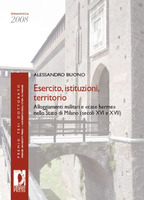Esercito, istituzioni, territorio. Alloggiamenti militari e «case herme» nello Stato di Milano (secoli XVI e XVII)
Abstract
What was the impact of the armies of the King of Spain on one of the territories of its composite monarchy during the centuries of the early modern age? What changes took place in the relations of power between the local institutions and the Madrid headquarters, between the Lombard corps and the city of Milan, between the representatives of the territorial corps and the power élites, as a consequence of the grievous burden represented by the military costs necessary for running the war? These are some of the questions that the author attempts to answer through study of the phenomenon of the military garrisons, an exceptional vantage point for observing the fine line that, in the ancient regime, divided the "military" and "civilian" worlds, which were not yet separated by the high walls and barbed wire of modern barracks. Quale fu l'impatto degli eserciti del re di Spagna su un territorio della sua composita monarchia durante i secoli della prima età moderna? Come mutarono i rapporti di forza tra le istituzioni locali ed il centro madrileno, tra i corpi lombardi e la città di Milano, tra le rappresentanze dei corpi territoriali e le élites di potere in conseguenza del grave peso rappresentato dagli oneri militari necessari alla conduzione della guerra? Queste sono le domande a cui si cerca di dare risposta attraverso lo studio del fenomeno degli alloggiamenti militari, osservatorio privilegiato di quel labile confine esistente in antico regime tra due mondi, il "militare" e il "civile", non ancora separati dagli alti muri e dai fili spinati delle moderne caserme.
Keywords
history; storia; army; esercitoDOI
10.26530/OAPEN_343708OCN
808383408Publisher
Firenze University PressPublisher website
https://www.fupress.com/Publication date and place
2009Series
Premio Tesi di Dottorato,Classification
Military history


 Download
Download